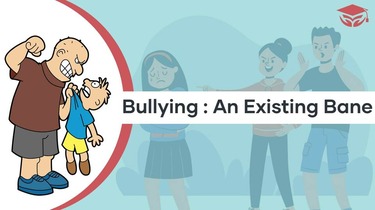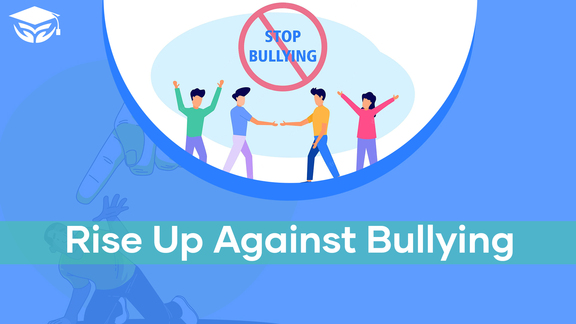
What is Bullying?
Schools have always been defined as a place where an individual has rich experiences. Academic years in a person’s life impact our behaviour, patterns of interpreting things or building an opinion system for certain things around us. Everybody’s experience differs in schooling years. Schooling is considered a phase that prepares a blooming bud for life.
Bullying definition is a negative reflection of aggressive behaviour in schools or educational institutes. In the U.S., Bullying affects nearly one in three American school children in grades six through 10. Another word for bullying could be peer pressure or harassment at educational institutions. The literal meaning of bullying at school would be defined as when a student or a group of students physically, verbally, or socially harasses another student in the name of humour perspective.
A bullying bystander would be defined as an individual or a group of people who don’t react to the bullying around them and don’t intervene in need of an hour. Earlier, the schools approach to tackling bullying cases was not that considerate and prompt, as both culprit and victim were juvenile students. Yet with time and severe reporting of bullying cases which lead to suicides and deaths of bully-victims, considerate strict rules and regulations came into the light.
Nowadays, cyberbullying is an existing bane being practised widely in which people anonymously target a person and humiliate them online with verbal abuse. Cyberbullying does leave people in serious distress and disrupts the basic working routine.
Characteristics of Bullying
Bullying hurts the victims, and it could have long-term. Three elements of bullying are described as follows:
- Intentional hurtful actions – It reflects the harmful actions that could impact someone physically, psychologically, emotionally, socially, and with low academic performance in a negative way. Certain behaviour could include name-calling or humiliating someone, or hitting someone. This disrespectful behaviour or gestures toward anybody would be intentional hurtful actions. In schools, children usually dont emphasize the moral harm they’re creating while bullying someone. Certain behaviour could avoid after educating children about the sensory consequences of bullying.
- Repeated behaviour reflects the lack of intervention at the first stage. When a child or group of children bullies someone, then one should be stopped and corrected at the same time for morally unethical behaviour. But if Nobody intervenes, the cycle of harassment could repeat, leading to serious circumstances.
- Imbalances of power – It reflects the dominance a bully implies on someone who is being bullied at school. A child develops a certain image after being a bully or a bully bystander. Being a part of a bullying culture doesn’t make anybody morally right and compliant. It directs the person who is a bully as mean and least approachable while the person who is being bullied as fragile. Being a bully does represent a quality of leadership coated in an abusive approach to demonstrate it.
Federal Guidelines on Bullying and Harassment
The federal government, in specific, doesn’t have separate laws or penalties for bullying. However, bullying is accounted in discriminatory harassment, which is quite overlapping. Yet if a student wishes to report the case of bullying, one can file a formal grievance with a school district authority addressing your concern. He/She can also address there concern by contacting and addressing the U.S. Department of Education’s Office of Civil Rights and the U.S. Department of Justice’s Civil Rights Division. These federal authorities will look into the matter of concern and intervene in the considerate period.
The state requires a certain parameter to decide whether the case is of bullying or harassment. State-specify guidelines to identify such cases and authorizes educational institutions to take actions under their territorial limits.
U.S. government has suggested anti-bullying laws to reduce or eliminate the practice of bullying at schools and workplaces. The first state to adopt an anti-bullying policy was Georgia in 1999, and the most recent one was Montana in 2015. Anti-bullying and harassment at educational institutions suggest that certain measures and training should organize within the premises to educate students about the severity and circumstances bullying could lead to.
Gradually, all 50 states do have separate laws and policies for bullying. Some states decide to rely on the prevailing act like Title IX of the Education Amendment Act, which prohibits gender-based discrimination or harassment at educational institutions.
While some chose to implement separate acts like RA 10627, which addresses the impact of a hostile environment in educational institutions, or RA 11036, which addresses the protection of people who’re taking mental health assistance
Effect of bullying on a child’s mental health
Bullying could lead to severe and long-term impacts on the victims. Even being bullied at a tender age could affect a child’s growth. Bullying could lead to lower self-esteem, lack of confidence, motivation, irritation, anxiety, disturbed sleep patterns, etc.
Children at a tender age don’t consider the severity of the situation and end up being a bully or a victim of bullying. For a victim, it’s difficult to strive for a healthy routine as the amount of distress and shame adjoined with the bullying is uncertain. Somebody’s actions in the ode of humour and fun could lead to mental scars. Low academic performance could also be one of the major consequences of bullying. Bullying at school would lead to certain insecurities, which would affect the personality and growth of an individual.
How to stop bullying?
Even after the prevailing laws and policies, preventive measures to reduce or eliminate the causes of bullying are as follows:
Bullying prevention measures schools and educational institutions should adopt,
- Sensitivity pieces of training should be put in motion among teachers and students to empathize with the victims and stop bullying bystanders.
- Educational institutions should make evident and prompt actions to leave an impact and make aware fellow children or not repeat the same mistake.
- Having a strict approach to the bully and an empathetic approach towards the bullied child.
- Not normalizing name-calling at schools and intervening in a matter of time.
Bullying prevention measures an individual could take to stop bullying,
- Intervening is when you spot somebody being a bully and call them out for their actions.
- Educating your social circles about the sensitivity and severity of bullying
- Normalizing talking about the trauma and other related issues and counting bullying as one of the facts.

10 facts about bullying that’d not let you be a bullying bystander anymore,
- At schools, girls are the major target of bullying. Sexual harassment or sexual violence does occur most with girls. Also, a study estimated that 83% of boys and 79% of girls do report harassment during schooling years.
- Considering the bystander effects, every 6 out of 10 students witness bullying incidents.
- Nearly 9 out of 10 students who’re confused about their sexual orientations or belong LGBTQ community do face bullying at school.
- Talking about the action taken on the reports, 70 % of the students thinks educational institutions responded poorly to their complaints.
- Bullying in school is a common practice which sometimes gets neglected by the teachers and decorum maintenance authorities. The common penalties for bullying are suspension, weekly rustication, or domestic duties at school.
- The most school doesn’t stay compliant with suggested bullying prevention policies.
- Registered cases of bullying and harassment are nearly a ¼ proportion of unregistered or unrecorded cases.
- Bullying and suicide are correlated factors. Having suicidal thoughts is common for someone bullied at school or could have a long-term psychological impact.
- Bullying and mental health are also correlated factors. A person who has faced bullying at the initial age is expected to have mental health issues like anxiety, depression or sleep deprivation, and other issues.
- Events like anti-bullying day, anti-bullying month or bullying awareness month are observed effectively in schools, yet effective programs to sensitize students about the consequences of bullying aren’t implemented.
Important Note
‘You might not be having a good day, but you will have one someday with good company.’
This quote suggests that even if you’re having a bad day just because somebody chose to target you and reflect all their negative emotions on you, you should opt up a voice to speak for yourself and stop that process of harassment with a single ‘no.’ Nobody is liable enough to carry somebody’s bad behaviour on them. We, humans, being social animals, should rely on people who feel like a safe space where we can open up about our daily struggles.




